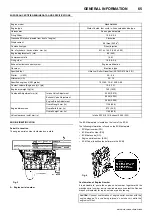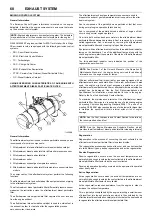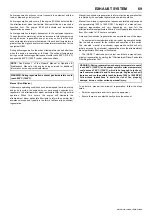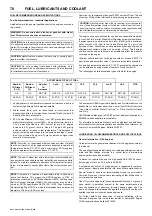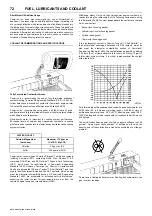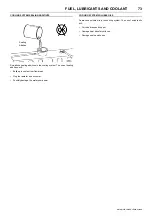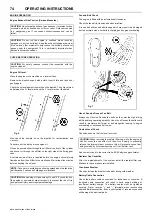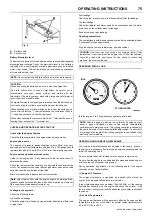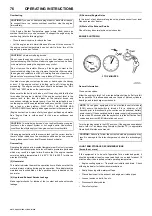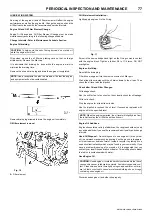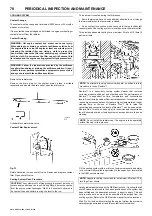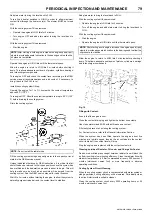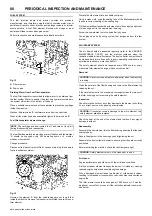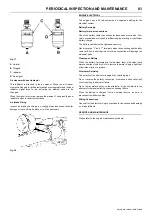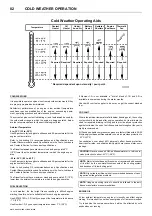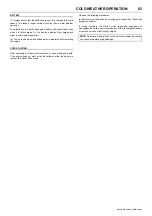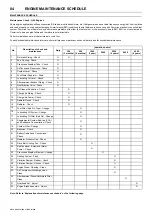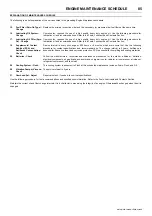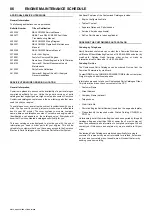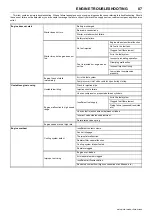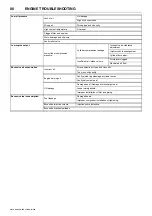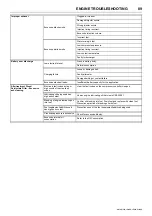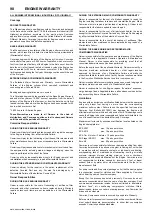
OPERATING INSTRUCTIONS
75
9/275, 9/305, 12/250, 17/240, 21/220
A.
Battery cable
B.
Connections
Battery Electrolyte level
The amount of electrolyte in the batteries will be reduced after repeated
discharge and recharge. Check the electrolyte level in the batteries,
replenish with a commercially available electrolyte such as distilled
water, if necessary. The battery electrolyte level checking procedure
will vary with battery type.
CHECKS AND OPERATION AFTER START-UP
Check after the Engine Start-up
Check the following items in the engine warming-up operation.
Engine oil pressure -
The engine oil pressure gauge readings (where fitted) may vary
depending on ambient temperature and type of oil. The gauge should
register around 55 to 75 psi (379 to 517 kPa) in the warming-up period.
Engine noise and exhaust smoke colour -
Listen to the engine and, if any abnormal noise is heard, check to
determine the cause.
Check the fuel combustion condition by observing the exhaust smoke
colour. The exhaust smoke colour after engine warm-up and at no-load
condition should be colourless or light blue.
Black or white smoke indicates incorrect combustion.
Leakage in the systems -
Check the following items:
Lubrication oil leakage -
Check the engine for oil leaks, paying particular attention to oil filter and
oil pipe joints.
Fuel leakage -
Check the fuel injection pump, fuel lines and fuel filter for leakage.
Coolant leakage -
Check the radiator and water pump hose connections and the water
drain cock on the cylinder block for leakage.
Exhaust smoke or gas leakage
Checking coolant level
The coolant level could drop because any mixed air is expelled in about
5 minutes after the engine started.
Stop the engine, remove radiator cap, and add coolant.
OPERATING WITH A LOAD
.
Idle the engine 3 to 5 minutes before operating with a load.
OPERATION AND CARE OF A NEW ENGINE.
Your engine is carefully tested and adjusted in the factory, however,
further run-in is necessary. Avoid any harsh engine operation within the
initial 100 operating hours.
Do not operate the unit at full load until the engine is warmed-up.
Do not allow the engine to run unloaded for extended periods so as to
minimise the risk of cylinder bore glazing.
During operation, pay attention to the following points if the engine
shows any sign of abnormalities.
(1) Engine Oil Pressure -
The engine oil pressure is monitored by a switch that will stop the
engine if the pressure falls below a pre-set value.
If the oil pressure gauge shows below 10 psi (69 kPa) or if the reading
fluctuates continually, stop the engine and check the oil level. If the
level is correct, contact your local Doosan branch or dealer to establish
the cause.
(2) Coolant Temperature -
The engine performance will be adversely affected if engine coolant
temperature is too hot or too cold. The normal coolant temperature is
82 to 93°C (180 to 200°F).
NOTE:
Do not replenish with dilute sulfuric acid in the daily service.
CAUTION:
When inspecting the batteries, be sure to stop the engine first.
As dilute sulfuric acid is used as electrolyte, be careful not to
contaminate your eyes, hands, clothes, and metals with the
electrolyte. If it gets in your eye, wash with a large amount of water at
once, then seek medical advice.
As highly flammable hydrogen gas is released from the batteries, do
not create a spark or allow any naked flame near the batteries.
When handling such metallic articles as tools near the batteries, be
sure not to contact the “+” terminal because the compressor body is
“-” and a dangerous short circuit might result.
When disconnecting the terminals, start with “-” terminal. When con-
necting them, connect the “-” terminal last.
Note:
After start-up from cold the engine might be noisier and the
exhaust smoke colour darker than when it has warmed up. However
this condition will disappear after warm up.
Fig. 8
CAUTION: Hot steam can rush out and you could get burnt if the
radiator cap is removed when the engine is hot. Cover the radiator
cap with a thick cloth and loosen the cap slowly to reduce the
pressure, then remove the cap.
NOTE:
After the engine is started, the voltmeter, if equipped, may
show a gauge fluctuation under certain engine temperature
conditions (both warm and cold). This cycling operation is caused by
the post-heat cycle of the intake manifold heater system. The number
of cycles and the length of the cycling operation is controlled by the
electronic control module.
3 TO 5 MINUTES
IDLE





